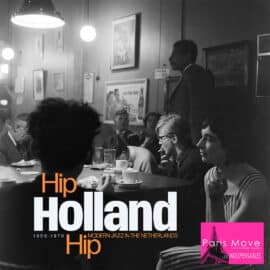| Jazz |

Long before the arrival of the internet in Europe, information barely trickled between countries, and even less so among neighboring countries. For many Europeans, the Netherlands had only a postcard image, wedged between Gouda, tulips, windmills, coffee shops, and people cycling through the streets of Amsterdam.
And then one day, we discovered a Dutchman unlike any other: Dick Annegarn. Fluent in French, poetry, humor, and possessing an extremely broad musical culture that one could only uncover during his concerts…
We knew there was jazz in the Netherlands, but it felt distant, so far away, yet surprisingly close. However, Sdban Records concocted a delightful cocktail, promising us, “Dive into the Dutch jazz scene of the 1950s and 1960s with a selection of classic and rare hard bop and cool jazz tracks from artists such as Herman Schoonderwalt, the Diamond Five, Wessel Ilcken, and Tony Vos. The Netherlands had never sounded so hip!”
And the recordings even go back to the 1970s. We find the arrangements particularly clever and modern, with a hint of discreet humor that is quintessentially Dutch, evident in both the titles and their compositions or arrangements. Imagine a track like “So Why,” which is undoubtedly an echoing response to “So What,” which is anything but a joke. Hip Holland, hip, luxurious bebop, shimmering from the depths of the nightclubs, dazzled by the headlights of cars parking nearby to attend one of these concerts, featuring remarkable recordings of exceptional sound quality, likely all recorded on Studer equipment given the sonic precision.
The origins of Dutch jazz? The roaring twenties, just before 1930, in Amsterdam, introduced jazz to the general public but also sparked the indignation of the early Dutch jazz purists. Although Whiteman was dubbed “The King of Jazz,” they considered his fusion of jazz with symphonic music as purely commercial and too “soft” compared to the “hot” Afro-American jazz they preferred. The establishment of De Jazzwereld magazine in 1931 (by future bandleader Red Debroy, who was only fifteen at the time!) and the Nederlandse Hot Club in 1933 were attempts to promote “authentic” jazz to the Dutch audience, contributing to the creation of a genuine jazz scene that was at its peak when the Swing era began in the mid-1930s.
Let us be carried away by the title “Work Song,” performed by The Frans Wieringa Trio featuring Eduard Ninck Blok. It’s one of those particularly warm interpretations, and this album-document is full of them, which is why the editors of Bayou Blue Radio and Paris-Move award the label “Essential” to this album, the perfect gift for all jazz enthusiasts for the holiday season.
Thierry De Clemensat
USA correspondent – Paris-Move
Editor in chief Bayou Blue Radio, Bayou Blue News
PARIS-MOVE, September 22nd 2023
::::::::::::::::::::::::::
To buy this this album: here or here
